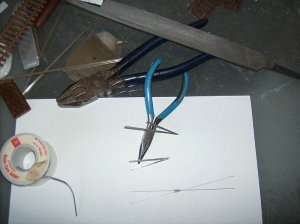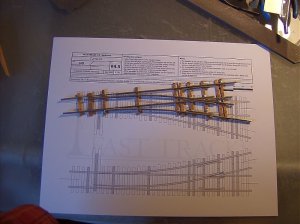Anybody have a sure-fire method for building frog points? Without buying the jig.
I have tried the Steve hatch method, Tetters and Hminky's , and still can"t get them right. Help please!
Loren
Not as pretty a result as the other methods, but it did work for me with my first layout with handlaid track. I used a method detailed by Jack Work in the April 1963
Model Railroader - note this works very well for NMRA HO standard flangeways. It might not work so well in other scales or flangeway sizes. For more detail, you might want to order a copy of the article from Kalmbach (publisher of
Model Railroader).
Basically you just file the frog point approximately in each rail and then spike the rails in place. Add the wing and closure rails (I used one piece to include the points with the wing and closure rails), and spike them in place. The bend in the wing rails does have to line up well with the frog rails. Now, fill the entire frog with solder up to the level of the rail heads.
Then, using a hacksaw blade, carefully saw out the flangeways. The flangeways will come almost perfect for HO. Use some files for final trimming.
This method does not require perfect filing of the frog point rails - the solder fills in any imperfections. Disadvantage is that deep, pizza cutter flanges will bump up on the solder filling unless you saw them nearly all the way down. And depending on much solder filling you use, the result may not look that prototypical.
An obvious question is why did the other methods fail you? I'm guessing you are not using an accurate template of your proposed turnout as the basis for filing/folding the frog point. Steve Hatch suggests laying out flex track where you want one leg of the turnout to go and taping thin paper over top and shading to "trace" the rail heads' positions. Fold the paper back to the tape and realign the flex track for the other leg. Trace those rail heads, too. Now you have a paper template showing exactly where the frog and points should be, with the correct frog angle.
my thoughts, your choices



